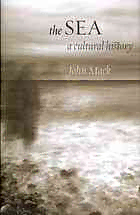
The Sea: A Cultural History PDF
Preview The Sea: A Cultural History
SEA the the sea SEA the reaktion books Published by Reaktion Books Ltd 33 Great Sutton Street London ec1v 0dx, uk www.reaktionbooks.co.uk First published 2011 Copyright © John Mack 2011 All rights reserved No part of this publication may be reproduced, stored in a retrieval system, or transmitted, in any form or by any means, electronic, mechanical, photocopying, recording or otherwise, without the prior permission of the publishers. Printed and bound in Great Britain by cpi/Antony Rowe, Chippenham, Wiltshire British Library Cataloguing in Publication Data Mack, John, 1949– The sea : a cultural history. 1. Ocean. 2. Ocean and civilization. 3. Seafaring life. I. Title 551.4'6-dc22 isbn978 1 86189 809 8 Contents Preface 7 Introduction 13 1 Different Seas? 36 2 Concepts of the Sea 72 3 Navigation and the Arts of Performance 105 4 Ships as Societies 136 5 Beaches 165 6 The Sea on the Land 188 References 219 Bibliography 242 Acknowledgements 258 Photo Acknowledgements 260 Index 261 Preface There are two separate strands which have come together in the plan- ning of this book – or rather two separate, but in the end related questions. The first is a negative one: why did no one apparently think it worth settling on the large island of Madagascar in the western Indian Ocean until late in human history? It is an island well-endowed by nature and, other than being inhabited by ferocious mosquitoes along its coasts, not inconvenienced by the lions, leopards or other predators that stalk the hinterlands of the nearby African continent. Its famous lemurs are benign residents posing no physical threat to human settlement. A second question is why – coincidentally at about the same time as Madagascar was finally being colonized – did the people of East Anglia take to burying a leader in a huge ship on the top of a hill? Sutton Hoo is a pleasant place above a sheltered inlet, a good place to bury a prominent person who would have been familiar with the maritime world along this part of the English coastline. But why drag a huge ship all the way up there to do it? The questions occurred in this sequence but at different moments several decades apart. The first obliges a reconsideration of what it means to be at sea and how the maritime world is constituted; the second implies bringing the subject back onto land to think about how the maritime and terrestrial worlds interact. The movement of the book that follows reproduces that sequence: it starts by thinking about human engagement with the sea in maritime terms, rather than merely as an extension of the activities of the land; and it ends by seeking to bring together the argument round a consideration of the grand ritual gesture of ship-burial. In between it ranges widely 7 The Sea across the literature on the human experience of the different oceans and seas. After working in various inland parts of eastern Africa – and having had the opportunity to spend time along the Swahili coast of Kenya and latterly Tanzania – the outbreak of civil war in southern Sudan in the early 1980s made it inadvisable to continue working with pastoralist communities in what was to become a war-torn area. The opportunity arose to begin an ethnographic survey on the island of Madagascar, which in those days was mostly approached by plane from Nairobi. The route lay over the north-west coast of the island with a clear sight of the soils leeching off the central highlands and turning the rivers and a wide semi-circle of the waters of the Mozambique Channel a distinctive brownish-red colour. Flying in to land in the highlands near the capital of Antananarivo has become the usual way of getting there. However, on subsequent visits I have been able follow an older practice and approached by sea from Zanzibar entering the ports at Mahajanga, Antsiranana (previously Diego Suárez) and, on the east coast, at Toamasina (Tamatave). What this experience makes entirely evident is both the proximity of ‘la grande île’ to inhabited lands and islands in the vicinity and also the availability of a number of sheltered harbours. So the island is vast, neither remote, lacking appropriate harbours (albeit dispersed ones) nor short of resources. True, it lies at the extremities of the monsoonal system which linked together the trading practices of the wider Indian Ocean world. Being off the beaten track, however, was not a criterion which limited the exploration and settlement of the Pacific, the North Atlantic or other areas which were colonized much earlier than Madagascar. Madagascar was not occupied until very late in human history – probably only within the last 1,200 to 1,500 years. The big question which has preoccupied those concerned with the antiquity of human activity in this part of the Indian Ocean concerns the question of whofirst colonized the island in the context of increased precision about whenthe event might have happened. Even if we set aside the questionable assumption that it was a single event, the whole detec- tive cast to this search is hard to avoid. There are a limited number of candidates who might have committed the deed, and, while the scenarios are conflicting, all have persuasive aspects. Much is down to the imagi- native powers of reconstruction of the researcher and the assessment of new pieces of information as they arise. However, as in the standard 8
